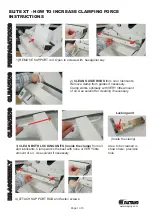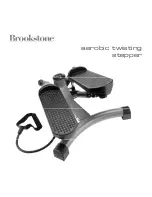
2. Look at NO. 04 in the JOURNAL 2. CNG (0003) indicates that the
CNG signal has been received three times since the purchase date.
For further details, see
2.4.7.1. JOURNAL 2
() and
2.4.7.2. JOURNAL 3
().
2.4.7.1. JOURNAL 2
Refer to JOURNAL 2 in
2.4.7.3. PRINTOUT EXAMPLE
().
Journal 2 displays the additional detailed information about the last 35 communications.
Descriptions:
(1) RCV. MODE
Indicates which receive mode the unit was in when the unit received a fax message.
This information is also displayed when the unit transmitted a fax message.
(2) SPEED
Indicates the speed of the communication. If multiple pages are transmitted or received, it
indicates the last page’s communication speed. If there is a communication error, "?" is
displayed.
(3) RESOLUTION
Indicates the resolution of the communication. If multiple pages are transmitted or received, it
indicates the last page’s resolution. If there is a communication error, "?" is displayed.
(4) RCV-TRIG. (CNT.)
Indicates the trigger that causes the unit to switch to the fax receive mode. The available options
are listed in JOURNAL 2 in
2.4.7.3. PRINTOUT EXAMPLE
(). The values in parentheses indicate
how many times the trigger has been used. (For example, "0003" means three times.)
No.
Display
Function
1
FAX MODE
Means the unit received a fax message in the FAX mode.
2
MAN RCV
Means the unit received a fax message by manual operation.
3
FRN RCV
Means the unit received a fax message by friendly signal detection.
4
VOX
Means the unit detected silence or no voice.
5
RMT DTMF
Means the unit detected DTMF (Remote Fax activation code) entered
remotely.
6
PAL DTMF
Means the unit detected DTMF (Remote Fax activation code) entered by a
parallel connected telephone.
7
TURN-ON
Means the unit started to receive after 15 rings. (Remote Turn On: Service
Code #573)
8
TIME OUT
Means the unit started to receive after Ring Time Out in the EXT-TAM or TEL
/FAX mode.
9
IDENT
Means the unit detected Ring Detection.
10
CNG OGM
Means the unit detected the CNG while it was sending the Dummy Ring
Back Tone in the TEL/FAX mode. / OR / Means the unit detected the CNG
while it was sending the OGM in the ANS/FAX mode.
11
CNG ICM
Means the unit detected the CNG while it was recording the ICM in the ANS/
FAX mode.
(5) ERROR
MEMORY
Indicates the reason why the unit received a fax message in memory.
If you look at No.11 in the JOURNAL 2 in
2.4.7.3. PRINTOUT EXAMPLE
(), it shows the fax
115
Summary of Contents for KX-FP80C
Page 9: ...1 10 OPTIONAL ACCESSORIES 1 11 TEST CHART 1 11 1 ITU T No 1 TEST CHART 9 ...
Page 10: ...1 11 2 ITU T No 2 TEST CHART 10 ...
Page 11: ...1 12 LOCATION OF CONTROLS 1 12 1 OVERVIEW 11 ...
Page 24: ...2 Push the back cover open button and open the back cover 24 ...
Page 30: ...1 15 2 1 MAINTENANCE LIST 30 ...
Page 38: ...Note Do not pull out the jammed paper forcibly before opening the front cover 38 ...
Page 40: ...2 Push the back cover open button and open the back cover 40 ...
Page 56: ...Fig C 2 3 4 12 ABLANK PAGE IS RECEIVED 56 ...
Page 71: ...71 ...
Page 72: ...CROSS REFERENCE 2 5 TEST FUNCTIONS 72 ...
Page 73: ...CROSS REFERENCE 2 5 TEST FUNCTIONS 73 ...
Page 74: ...CROSS REFERENCE 2 5 TEST FUNCTIONS 74 ...
Page 75: ...CROSS REFERENCE 2 5 TEST FUNCTIONS 75 ...
Page 76: ...76 ...
Page 77: ...77 ...
Page 78: ...78 ...
Page 90: ...2 3 6 3 CHECK THE STATUS OF THE DIGITAL BOARD 90 ...
Page 93: ...3 No ring tone or No bell CROSS REFERENCE 2 3 7 1 CHECK SHEET 93 ...
Page 96: ...2 3 8 2 TOROUBLESHOOTING FLOW CHART 96 ...
Page 97: ...97 ...
Page 98: ...98 ...
Page 102: ...CROSS REFERENCE 2 5 TEST FUNCTIONS 102 ...
Page 103: ...2 3 12 THERMAL HEAD SECTION Refer to 6 4 3 THERMAL HEAD 103 ...
Page 105: ...2 4 3 USER MODE The list below is an example of the SYSTEM SETUP LIST the unit prints out 105 ...
Page 106: ...Note The above values are the default values 2 4 4 SERVICE FUNCTION TABLE 106 ...
Page 117: ...117 ...
Page 122: ...2 Left margin Top margin Reference pattern 122 ...
Page 123: ...3 Thermal head 1 dot Reference pattern 123 ...
Page 127: ...4 2 HOW TO REMOVE THE OPERATION PANEL BLOCK 127 ...
Page 128: ...4 3 HOW TO REMOVE THE OPERATION BOARD AND LCD 128 ...
Page 129: ...4 4 HOW TO REMOVE THE ANALOG DIGITAL AND POWER BOARDS AND AC INLET 129 ...
Page 130: ...4 5 HOW TO REMOVE THE MOTOR BLOCK 130 ...
Page 131: ...131 ...
Page 132: ...4 6 HOW TO REMOVE THE SEPARATION ROLLER 132 ...
Page 133: ...4 7 HOW TO REMOVE THE IMAGE SENSOR CIS 133 ...
Page 134: ...4 8 HOW TO REMOVE THE TERMAL HEAD 134 ...
Page 135: ...4 9 HOW TO REMOVE THE PLATEN ROLLER BACK COVER 135 ...
Page 136: ...4 10 HOW TO REMOVE THE PICKUP ROLLER 136 ...
Page 137: ...4 11 HOW TO REMOVE THE CASSETTE PLATE 137 ...
Page 138: ...4 12 HOW TO REMOVE THE DOCUMENT TRAY 138 ...
Page 139: ...4 13 INSTALLATION POSITION OF THE LEAD WIRES 139 ...
Page 146: ...6 7 1 ANALOG UNIT BLOCK DIAGRAM 6 3 CONTROL SECTION 6 3 1 BLOCK DIAGRAM 6 3 2 MEMORY MAP 146 ...
Page 147: ...6 3 3 ASIC IC501 This custom IC is used for the general FAX operations 147 ...
Page 149: ...149 ...
Page 152: ...58 TEST3 I 5V HIGH FIXED 152 ...
Page 154: ...102 RBA4 O 5V ROM RAM BANK ADDRESS 4 154 ...
Page 170: ...Note See Sensor Locations in 6 5 SENSORS AND SWITCHES 6 4 6 3 2 TRANSMITTING DOCUMENTS 170 ...
Page 171: ...CROSS REFERENCE 2 3 10 SENSOR SECTION 6 4 6 3 3 RECEIVING FAX 171 ...
Page 172: ...Note See Sensor Locations in 6 5 SENSORS AND SWITCHES 6 4 6 3 4 COPYING 172 ...
Page 196: ...AND DIODES 8 FIXTURES AND TOOLS 196 ...
Page 197: ...9 CABINET MECHANICAL AND ELECTRICAL PARTS LOCATION 9 1 OPERATION PANEL SECTION 197 ...
Page 198: ...9 2 UPPER CABINET SECTION 198 ...
Page 199: ...9 2 1 BACK COVER SECTION 9 2 1 1 BACK COVER 1 199 ...
Page 200: ...9 2 1 2 BACK COVER 2 200 ...
Page 201: ...9 3 LOWER P C B SECTION 201 ...
Page 202: ...CROSS REFERENCE 9 1 OPERATION PANEL SECTION 9 4 MOTOR SECTION 202 ...
Page 203: ...9 5 ACTUAL SIZE OF SCREWS AND WASHER 10 ACCESSORIES AND PACKING MATERIALS 203 ...
Page 204: ...11 REPLACEMENT PARTS LIST 204 ...
















































